My Heart Is Racing and Its 4 Am Dont Know if Its the Drinks or Im in Love Again
Postural Orthostatic Tachycardia Syndrome (POTS) is both mystifying and misunderstood by nearly everyone, including most doctors. A relatively new disease, POTS still lacks a set of universally followed, predefined treatment guidelines. (This often results in confusion and frustration among patients and their physicians.) Instead of regurgitating the little information about POTS that can be found in medical textbooks, we decided to survey POTS patients (over 900 of them). By combining the largest survey of POTS patients ever conducted, our experience treating the disease, and the most recent medical literature on the topic, we hope to help demystify the medical mystery that is POTS.
This guide – which we're calling the POTS Center – is intended to be the most comprehensive online resource on POTS. The POTS Center will be constantly updated to reflect the most current literature related to POTS. This page includes an overview of the disease, along with the most notable findings in our survey. Please don't forget that each section has a page dedicated to it, where you can find more in-depth information. All content is written by one of MyHeart's volunteer cardiologists and then reviewed by at least two others.
So without further ado, we welcome you to the POTS Center – a small place on the internet where we combine real patient feedback with published information and our own experience treating the disease – with the hope we can make the lives of those suffering from POTS a little easier.
What Is POTS? A Brief Definition
POTS is a form of dysautonomia that affects the flow of blood through the body, thereby causing dizziness when standing. Technically, someone has POTS if their heart rate increases by 30 beats per minute or their heart rate is greater than 120 beats per minute within 10 minutes of standing up.
The autonomic nervous system regulates involuntary actions that allow the body to function. When we stand, for example, the body needs to accommodate an entire set of processes to allow this. Upon standing, a significant amount of blood automatically falls to the lower body. Autonomic reflexes ensure that blood gets appropriately distributed to the upper body by changes such as muscle tone, vessel tone, heart rate, and pumping responses in the heart.
 There is a range of diseases that affect the autonomic nervous system known as dysautonomia. POTS is one of them. In POTS, there is increase in heart rate and light-headedness on standing, as well as exercise intolerance, fatigue, and a multitude of other symptoms. POTS may be so severe that even normal everyday activities usually taken for granted such as bathing or walking may be severely limited.
There is a range of diseases that affect the autonomic nervous system known as dysautonomia. POTS is one of them. In POTS, there is increase in heart rate and light-headedness on standing, as well as exercise intolerance, fatigue, and a multitude of other symptoms. POTS may be so severe that even normal everyday activities usually taken for granted such as bathing or walking may be severely limited.
Although anyone can be affected by postural tachycardia syndrome, it is by far most prevalent among woman in their teens, twenties, and thirties. There is a wide spectrum of POTS-like disorders that falls under the umbrella of dysautonomia, several of which do not have the increase in heart rate.
Symptoms
POTS is most commonly known for causing dizziness upon standing. In some cases, patients actually faint when trying to stand, earning POTS the nickname of "the fainting disease". However, dizziness and fainting are just a few of the many often debilitating symptoms POTS patients battle on a daily basis. Additional symptoms include:
- Headaches
- Nausea
- Abdominal pain
- Chronic Pain (General)
- Chest Pains
- Heart Palpitations
- Fatigue
- Shortness of Breath
- Insomnia
- Brain Fog
- Sweating Abnormalities
- Weakness
- Bladder Dysfunction
- Tremors
According to our survey, fatigue (95.2%) is the most common symptom – which isn't surprising considering the commonality of POTS and Chronic Fatigue Syndrome (CFS). Dizziness when standing is the second most common symptom (95.2%), followed by brain fog ( 93.1%), and heart palpitations (92.0%).
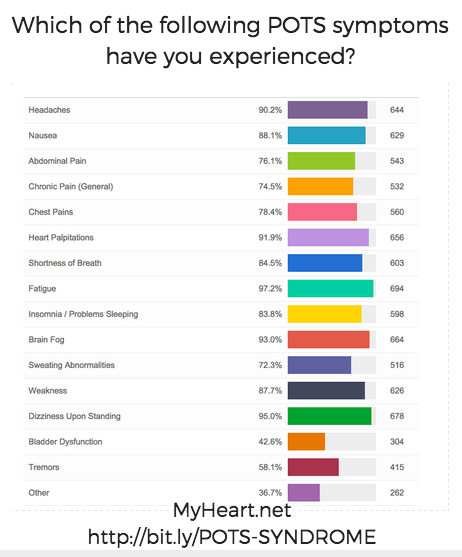
When reviewing these symptoms, it's no wonder POTS is called "the invisible illness" – nearly every symptom is subjective.It's important to remember that although dizziness is the trademark symptom, POTS does a lot more than just make someone dizzy.
Of the symptoms, patients report fatigue to be the most problematic or troubling symptom associated with POTS. Fatigue is also to blame for many of the complications that come with POTS. For example, it's common for teenagers with POTS to have a hard time getting to school on time in the morning. Patients also find it incredibly difficult to get out of bed at all. People suffering from POTS can find themselves in a frustrating cycle – they won't feel better unless they're active, yet they don't' have the energy to be active. Frustratingly, with POTS the symptom seemingly preclude its treatment, i.e. it's very difficult not have a sedentary lifestyle without enough energy to get out of bed, much less run several miles every day.
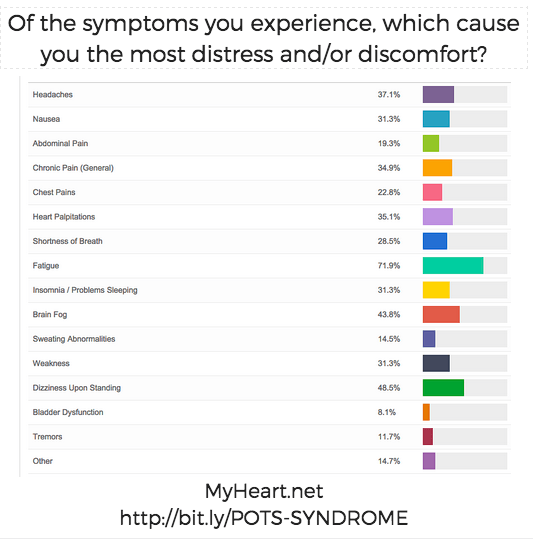
Dizziness (48.5%), brain fog (43.8%), headaches (37.1%), and chronic pain (34.9%) were rated the most challenging symptoms after fatigue (71.8%). You can read more about POTS symptomology here. Brain fog is a unique symptom associated with POTS. We have a section dedicated to brain fog and POTS here.
Diagnosis of POTS
POTS is typically diagnosed through a variety of tests, the most common of which is called a tilt table test. With this test, patients are strapped to a table which is tilted to simulate the process of standing up by forcing blood from the upper body to the legs. Tilt tables aren't available at all hospitals, so some doctors diagnose POTS by monitoring changes in heart rate and blood pressure while the patient moves from laying down to standing up.
Various types of doctors can diagnose POTS, but our survey found that cardiologists most commonly diagnose the disease. We should note that a large percentage of respondents who selected "Other" indicated a neurologist diagnosed their condition. Click here to read our detailed section of diagnosing POTS.
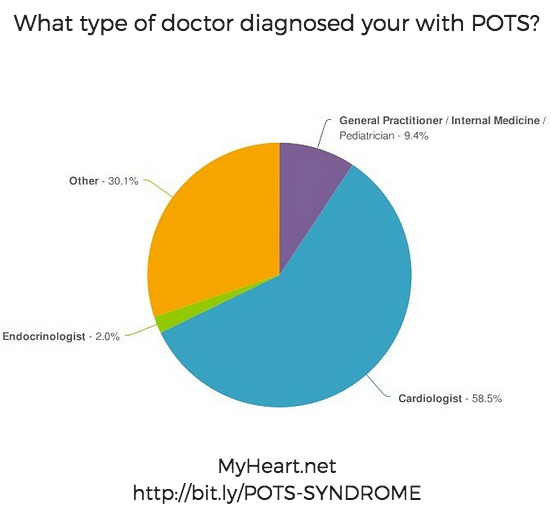
Challenges Faced by People Being Diagnosed with POTS
Unfortunately, individuals often face a number of barriers before and while being diagnosed with POTS. The reasons for this require further research. Nonetheless, it is currently far too difficult for patients with POTS to receive proper diagnosis and treatment.
For example, Postural Orthostatic Tachycardia Syndrome is often misdiagnosed by doctors' as anxiety, panic attacks, depression, or some other psychological disorder. Of those surveyed, over 78% said it was suggested they suffered from a psychological not physical, disorder when being diagnosed.
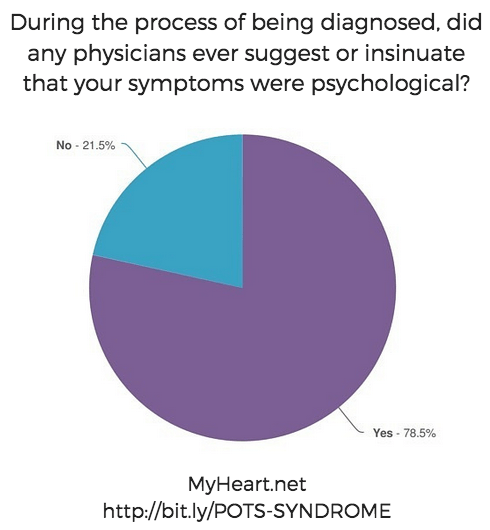
There is no medical evidence that people with POTS are predisposed to anxiety or panic attacks. On the contrary, existing literature suggests individuals suffering from POTS are as likely or less likely to have a mental disorder than the average population.
Another notable finding in our survey is the amount of time patients can suffer from often debilitating symptoms before receiving proper treatment. Nearly half stated it took more than 2 years to receive a diagnosis.
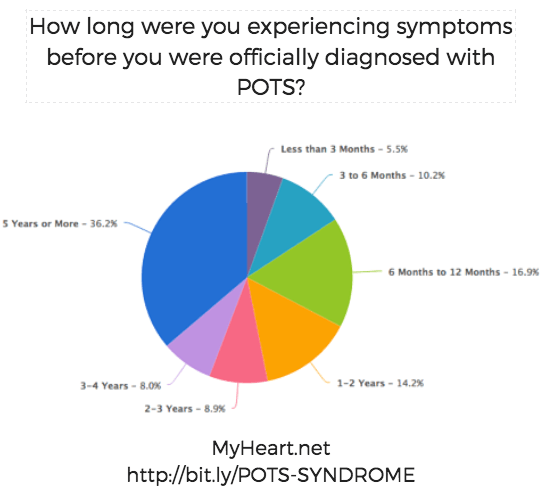
While we don't know the reason it's so difficult for patients to receive proper treatment for POTS, we can conclusively say that it's not because these patients aren't trying to understand the cause of their symptoms.
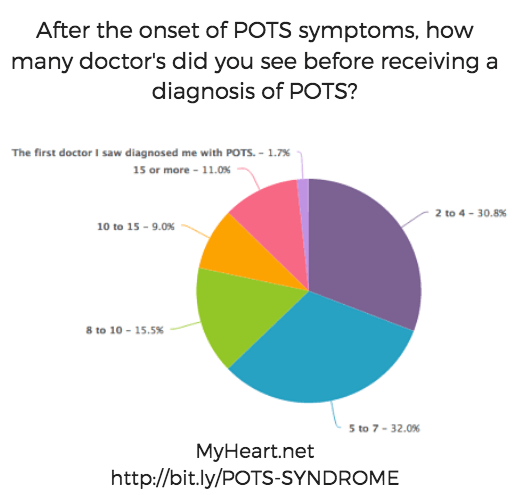
Making this worse – and as is the case with nearly any medical issue – receiving a proper diagnosis is key to improving POTS patients' quality of life.
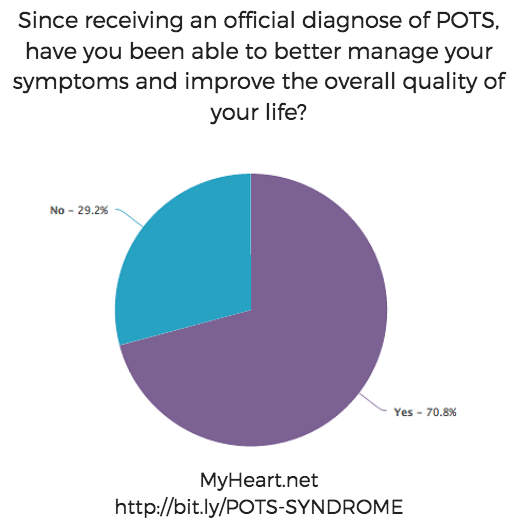
Treatment of POTS
There are three primary treatments for primary POTS; diet, exercise, and medication. Diets that are high in sodium and low in gluten have proven to be effective in some patients. (You can find more on the best POTS diet here.) It's also important that those suffering from POTS exclude certain items from their diet, which you can read more about here. Exercise has also been proven to help patients address some of the symptoms they experience. You can read more about how exercise helps in this section. Finally, several medications – and combinations of medications – can help to relieve POTS. Click here to read our in-depth section about treatments and specific medications used for POTS.
The Most Effective Treatment?
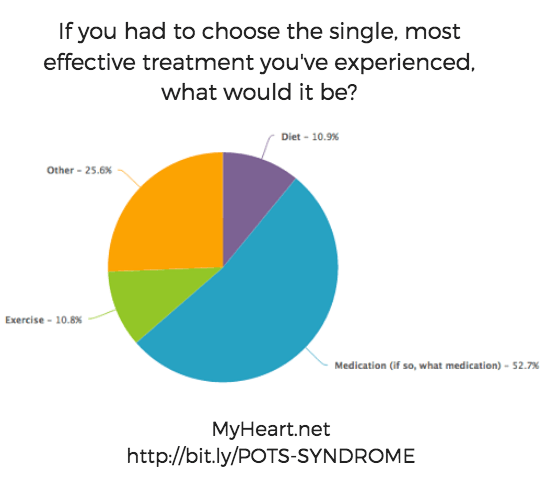
In our survey, we asked patients whatthey foundto be the most effective treatment for POTSin their experience. Over 53% indicated medication(s) were most helpful, followed by diet (11.1%) and exercise (10.5%). ("Other" was the second most common response, with over 25%. We hope to learn more about these treatments by working with the POTS community in the future.) As physicians, we don't feel comfortable endorsing medication as the single best treatment, because there's so much variation from patient to patient. The best course of action is to work with your doctor to find a treatment plan that works for you. You can find scientifically-supported treatments and the corresponding literature in our section detailing POTS treatments.
Types of POTS
We cover the types of POTS in more detail here. In summary, POTS is divided into a few types – neuropathic and hyperadrenergic. Neuropathic POTS relates to a disorder in the nerves that prevent blood from being pushed back up to the heart from the legs. Hyperandrenergic POTS is related to high levels of norepinephrine as the source of the symptoms. Furthermore, the disease can be classified as Secondary POTS. In this classification, the dysautonomia is a result of another condition or disease in the body. Click here to find a more detailed explanation of the types of POTS.
What Causes POTS?
POTS is a very complex disease that can have many causes. Generally speaking, causes of POTS are broken down into two sections: primary causes and secondary causes. Primary causes of POTS are often the source of the disease for younger patients. Some of the primary cause agents of POTS include nitric oxide, neuropathy, physical deconditioning, and various viruses. Secondary causes of POTS are when another disease or condition cause the disease. Some examples of secondary causes include:
- Anemia
- Adrenal Disorders
- Ehlers-Danlos
- Lyme Disease
- Tumors
- and many others
Read this section on "Causes of POTS" for a much more comprehensive list of causes along with supporting medical literature of each.
A Call For Awareness & Understanding
Some estimate that roughly 500,000 people in America suffer from POTS; however, with the difficulty associated with receiving a diagnosis there's no telling how many patients have POTS and don't even know it. While we don't have any short-term or easy solutions for these problems or homeopathic cures to provide, there are a few points worth making.
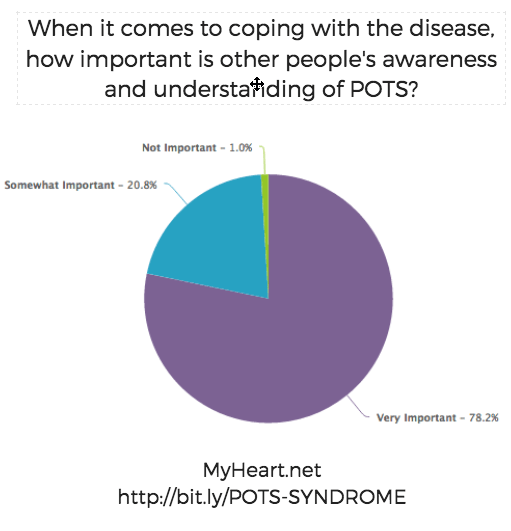
It's fair to conclude that increasing awareness about this mysterious disease – not just among those who have POTS but among their friends, family members, and loved ones – helps the patients manage their condition and, perhaps more importantly, believe they can overcome a challenging condition.
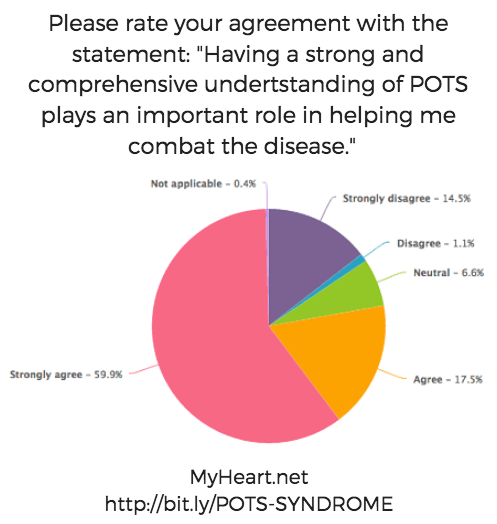
It's this statistic that motivated us to create the POTS Center. We'd encourage you to share this resource – or if not this resource, any medically accurate and helpful resource on POTS – with anyone you see fit. You never know who may have POTS but, due to challenges mentioned above, never got the diagnosis that could help them regain control over their life.
About the Survey
The survey was conducted via Facebook Groups dedicated to POTS Syndrome. We asked that only people with an official diagnosis take part; however, no additional efforts were made to "proof an official diagnosis". Thank you so much to all of those that participated!
References & Resources
Review Articles
Adolescent fatigue, POTS, and recovery: a guide for clinicians. Kizilbash et al. A comprehensive review of POTS, mainly written for clinicians, excellently written.
Postural tachycardia syndrome (POTS). Raj. An excellent review article on POTS in a highly reputable journal.
Postural tachycardia syndrome: a heterogeneous and multifactorial disorder. Benarroch et al. A review article on POTS.
Source: https://myheart.net/pots-syndrome/
0 Response to "My Heart Is Racing and Its 4 Am Dont Know if Its the Drinks or Im in Love Again"
Post a Comment